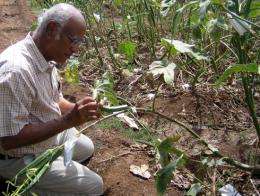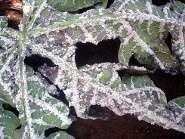Entomologist helps Asian farmers fend off papaya mealybug

A Virginia Tech researcher found sticky residue on a papaya leaf in Indonesia in the spring of 2008, a discovery that would help him save the livelihoods of thousands of farmers in Asia.
Rangaswamy "Muni" Muniappan, director of a U.S. Agency for International Development-funded program at Virginia Tech, had been carrying out a survey on the island of Java when he found a papaya tree infested with the papaya mealybug at the Bogor Botanical Gardens. Muniappan, an entomologist, popped the insects he believed responsible for the destruction into tiny alcohol-filled vials he carried. Back in the United States, he obtained confirmation: The insect in question was, as he suspected, the papaya mealybug.
Muniappan heads up the Integrated Pest Management Collaborative Research Support Program, a venture that works in developing countries to minimize crop losses, increase farmer income, and decrease pesticide use. The program is managed by Tech's Office of International Research, Education, and Development.
Several months after his Indonesia finding, Muniappan also confirmed the presence of the nefarious insect in South India.

If an infestation of papaya mealybug was left unchecked, it could destroy thousands of acres of papaya orchards and spread to other tropical countries throughout Asia. Many people would lose their livelihoods. In South and Southeast Asia, papaya is grown for local consumption and for commercial export to Europe and the United States.
While papaya is an exotic fruit in the northern hemisphere, it is one that many of us use unknowingly every day. Papain, a product of papaya, is used to make chewing gum, shampoo, toothpaste, and tooth whiteners. It is also used as a meat tenderizer and in the brewing and textile industries.
Even though the pest is called the papaya mealybug, it feeds on other plants, including cassava, beans, eggplant, melons, hibiscus, plumeria, pepper, sweet potato, tomato, citrus, mangoes, and mulberries, which are a key component in India's vital silk industry.
The most effective solution, Muniappan said, was to use classical biological control: introduce a species' natural enemies. For the papaya mealybug, this is a parasitic wasp that is extremely effective because it is species-specific, only preying on the papaya mealybug. Adult wasps lay their eggs inside the mealybug larvae. When the eggs hatch, the immature wasps eat the mealybug larvae until the larvae die.
Muniappan advised Asian scientists to contact government authorities in both Indonesia and India. The wheels of government turn slowly, so it wasn't until August 2010 that extension agents released the parasitic wasps in southern India.
Six months later, the tactic had proven so successful that farmers in the south of India held a celebration in the town of Sathyamangalam, in the foothills of the Western Ghats, Muniappan said. Hundreds of farmers and government officials came and heard speeches about the origins, spread, and control of papaya mealybug around the world. The event was covered by Indian news media. Muniappan gave one of the speeches.
The event was satisfying for two reasons, Muniappan said. "They recognized the contribution of our program in controlling the papaya mealybug in India," he said. Second, "it was rewarding to know that we had helped a country conquer a devastating scourge."
Provided by Virginia Tech


















